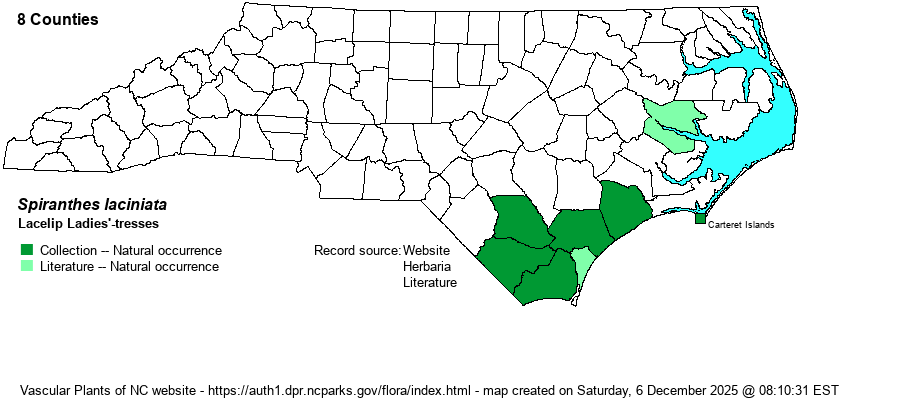| Author | (Small) Ames | |
| Distribution | Restricted in the state essentially to the southeastern corner, from barrier islands of Carteret County (Portsmouth and Shackleford Islands) southwest to Columbus and Brunswick counties. There is an isolated record from Beaufort County. Specimens at Catawba College from Rowan County must certainly be incorrect.
This species is generally found in the Atlantic and Gulf Coastal Plains, from NJ south to southern FL and west to eastern TX. However, it is apparently not known from MD or VA, and thus the NJ populations are quite disjunct. | |
| Abundance | Rare in the southeastern Coastal Plain; very rare north to Beaufort County. This is a State Special Concern species. | |
| Habitat | This species has a rather restricted habitat, somewhat different from most other Spiranthes in the state. It is generally a pool or pond species -- found in cypress depressions, margins of natural lakes and ponds, interdune marshes, and other wet ground where the waters are not flowing. | |
| Phenology | Blooms from May to August, and fruits shortly after flowering. | |
| Identification | This is, or is one of, the tallest species of Spiranthes in the state, generally with a moderately thick stem growing to about 2-2.5 feet tall. The upper part of the stem can be noticeably pubescent/hairy. The flower cluster is often 1 foot or more long and consists of a single rank of white flowers that can be rather secund or can be gradually spiraled, but is not strongly spiraled. The flowers are often 1/3-inch long, larger than on most others in the genus. The lip is typically yellow in the center. Though there are a number of flower characters that can be used to identify it, most biologists would likely identify it by its quite coarse and tall stem, growing in shallow water in a pool, pond, or lake margin, its yellow on the lip, and its midsummer flowering period. As it has such rare and special habitats, most biologists are not likely to discover a new population in the state. | |
| Taxonomic Comments | None
| |
| Other Common Name(s) | None | |
| State Rank | S2 | |
| Global Rank | G4G5 | |
| State Status | SC-V | |
| US Status | | |
| USACE-agcp | FACW link |
| USACE-emp | OBL link |

